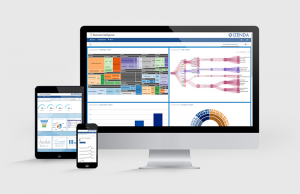 Business Intelligence (BI) Software provides significant benefits that include simplifying decision-making and revealing new opportunities, but companies must first lay the groundwork for BI software to aid them in such ways. In order to adjust to this requirement, organizations are encouraged to undergo a robust evaluation and data structuring period before making a BI software purchase decision. Otherwise, capitalizing fully on BI software will be an impossibility.
Business Intelligence (BI) Software provides significant benefits that include simplifying decision-making and revealing new opportunities, but companies must first lay the groundwork for BI software to aid them in such ways. In order to adjust to this requirement, organizations are encouraged to undergo a robust evaluation and data structuring period before making a BI software purchase decision. Otherwise, capitalizing fully on BI software will be an impossibility.
Fortunately, the process of preparing for BI implementation is not quite as rigorous as it may seem. Here are some steps organizations can take to get ready to make the most out of every bit of data they create using novel BI solutions:
-
Decide on the Principles of Your BI Approach
What do you hope to get out of using BI? What areas of your business or departments do you think would use BI-generated insights the most? How much time do you want your own employees to spend on maintaining or improving BI functions compared to assistance from an outside vendor?
Answering questions like these helps you address the broad, sweeping needs and goals that have driven your organization to consider using BI software in the first place. Audit these current needs and goals along with how you expect BI to affect them in order to sketch a general idea of your upcoming BI strategy.
Ensure that all major stakeholders have a say during this period of quantifying BI objectives so that the process can continue smoothly.
-
Hone in on a Defined BI Strategy
With general questions out of the way and lists of overarching, needs, concerns and goals, you can then begin laying down a specific blueprint for how BI will be grafted onto your organization’s information processing and decision-making functions.
One place to start would be to chart how information is expected to flow into the BI system. Many companies have separated, non-standard data repositories that lead to BI issues like redundancy, incomplete data sets or too narrow of a scope.
Also, appoint roles who will manage information and help oversee the general process of routine BI system use and maintenance. These roles should be driven by business goals, but should have some level of IT expertise to ensure that best practices are being followed.
Most importantly, determine the most important metrics your organization will track in order to develop actionable insights and capitalize on the generated BI reports.
-
Streamline Data Sources
Data retrieval should be efficient, seamless and full of clean, quality sources. The first two requirements mean that organizations must spend time mapping out how day-to-day data will be sent, stored and accessed by BI tools. An overall architecture of your data systems should be developed, either with in-house servers or off-site data warehousing storage.
Even once data is traveling at optimum speeds and without issues, it will still need to be “cleaned” so that only accurate, useful values are entering the BI system. Data should be audited periodically, and some degree of automation is usually necessary so that employees can focus on making and using data rather than simply poring over it manually.
-
Commit
Once you have the architecture in place both for your data and for your BI program, you will want to actively research and pursue the best BI software or system option for you. Whether this solution will be a software-as-a-service, an in-house hosted system, a proprietary turn-key product or something that lies in between, the product should meet the needs of your organization as it scales and encompasses new goals.
Once implemented, commit fully to using BI with support from every level of the organization along with encouragement to embrace BI tools. Otherwise, returns will be hard to visualize because of inconsistent adoption.
-
Use, Refine, Rinse Repeat
Once adoption is commonplace, valuable insights will be generated that help guide organizational decisions and strategies. In light of these insights, employees should make incremental adjustments and then measure the results. Over time, a refined strategy can be developed that helps BI-equipped companies see the highest return from their initial investment.
Conclusion: Take It One Step at a Time
As you can see, there is a significant amount of prep work involved for companies and organizations that want to get the highest possible benefit from their BI implementation. Fail to prepare beforehand, and your BI program will be unable to live up to its potential. Instead, strategize, structure and support BI operations consistently, and you will notice a marked difference in the confidence and performance of your company.
Need help choosing the right business intelligence solution? Izenda’s solutions experts can help.
Follow Izenda on social media for the latest on technology and business intelligence:
![]()
![]()
![]()

